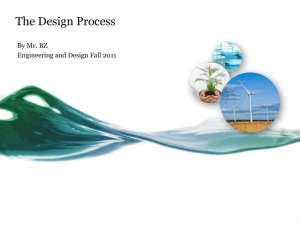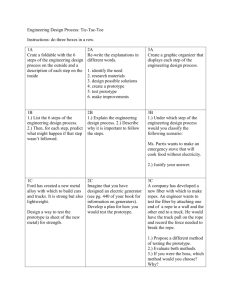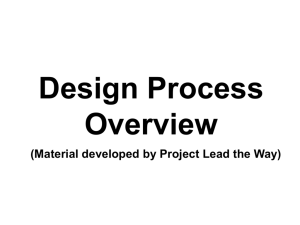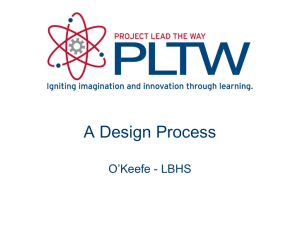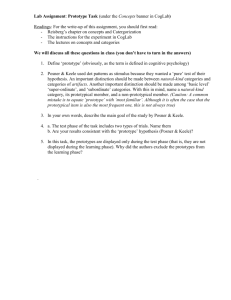Prototyping
advertisement
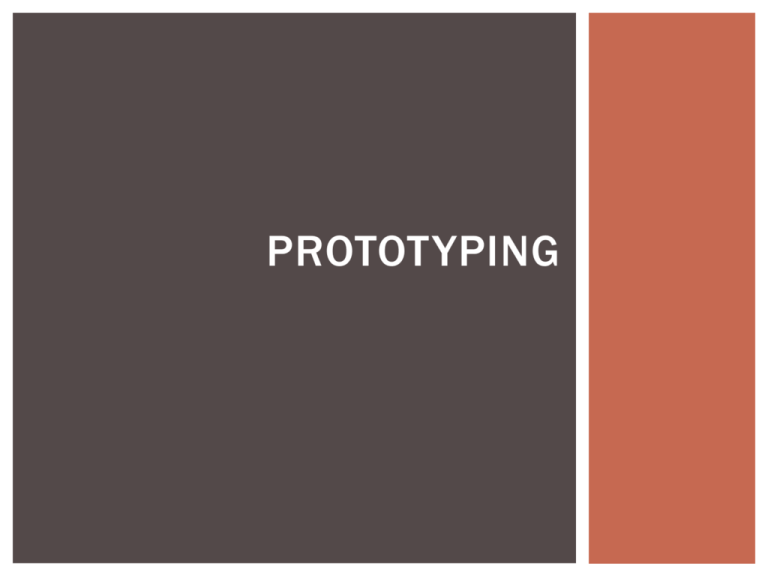
PROTOTYPING AGENDA Why bother with prototypes? Approaches to prototyping Dimensions of fidelity Prototyping in practice INTRODUCTION WHAT IS A PROTOT YPE? A prototype is an incomplete, early version of a product There are many approaches to building prototypes for software user interfaces UI prototypes can be as simple as a drawing on a piece of paper or as complex as web application Or anywhere in between those extremes! A cellphone prototype. WHY BOTHER WITH PROTOT YPES? Prototyping is an integral part of the UI design process You wouldn’t just sit down and start churning out Java without designing your class structure …we hope Similarly, you should not try to write code for a frontend without mocking it up beforehand BENEFITS OF PROTOT YPING Low cost: requires little time, technical expertise High return on investment: Getting user feedback early in the design process Uncovers problematic design choices before they are committed to code Minimizes miscommunication between designers Generally results in a better UI TYPES OF PROTOTYPES LANGUAGE CAVEAT There is no universal vocabulary for prototyping When you’re out in the “real world”, you will probably find that any one of these words can refer to many things And that one sort of prototype can have many names even within the same team It’s a good idea to double -check that you and your coworkers are on the same page WIREFRAMES Visual representations of an interface’s intended layout, typically without its actual content Good for evaluating content placement http://uxmatters.com/mt/archives/2007/03/wireframingwith-patterns.php COMPOSITIONS (“COMPS”) Static prototypes which focus on graphic design decisions, including colors, fonts, layouts, logos, media, etc. Good for evaluating aesthetic choices http://anthonysanders.us/blog/2009/05/comp-designs-forganache-restaurant-and-bakery/ STORYBOARDS Inspired by storyboards used by animators Series of images which represent how an interface would be used to accomplish a task Could be a FSM or a narrative Good for evaluating workflow http://net.typepad.com/net/2007/07/storyboards-as-.html PAPER PROTOT YPES Paper representations of an interface used to simulate interaction Good for evaluating general concept, specific workflows, and usability http://felixberger.info/wp-content/uploads/2008/09/br_online__prototype.jpg DIGITAL PROTOT YPES Interactive—but not necessarily functional —user interfaces created with any of a number of platforms E.g. Adobe Flash, HTML/CSS, etc. Good for evaluating a working design which has been derived from a few rounds of less costly prototypes PROTOTYPE FIDELITY LO-FI VS. HI-FI Traditionally, prototypes are categorized as either lo -fi (low fidelity) or hi-fi (high fidelity) Fidelity can be thought of as how close of an approximation of the final product is being attempted In this class, we will be using lo -fi as a synonym for paper prototyping and hi-fi as a synonym for digital prototyping But as you are about to see, it’s actually more complicated than that! DIMENSIONS OF FIDELIT Y Fidelity can be broken down into four basic dimensions: http://www.sapdesignguild.org/editions/edition7/proto_design. asp http://six-16.com/ux/index.html Breadth Depth Look Interaction BREADTH The “breadth” of a prototype refers to how much of the product’s functionality is represented in the prototype A very narrow prototype only represents a single feature A broad prototype represents all intended functionality Prototypes should generally be as broad as needed to cover basic tasks, but not much more DEPTH The “depth” of a prototype refers to how much of the prototype’s backend is functional, and how robust it is A very shallow prototype has no backend at all and is hard -coded to respond as though the user had provided ideal input A deep prototype has some logic and error -handling capabilities At first glance, depth may seem unimportant, but it affects the amount of exploration a user can do Thus depth can actually have a profound influence on user testing! LOOK “Look” is probably what most people think of when they think of prototype fidelity It refers to how accurately a prototype represents the product’s intended appearance, including fonts, colors, and graphics It’s generally a good idea to hold of f on something which has a high fidelity look until later in the design process INTERACTION “Interaction” refers to how the prototype handles input and output For example, you might create a digital prototype for an iPad application which runs on your desktop and responds to traditional a traditional mouse and keyboard Do not confuse interaction with depth! IN PRACTICE GATHERING DATA Who are your users? What tasks are they trying to accomplish? Don’t guess—do your research! Observe users in their natural habitats Check out solutions that already exist (even hacky ones) Make sure you are focusing on a problem at the right level of detail At this stage, don’t think “bicycle cup holders” Think “helping cyclists stay hydrated without getting hit by a car” BRAINSTORMING WARM-UP It can be helpful to do some sort of warm -up before you start brainstorming You could allot ~5 minutes to free -form chatter about related products or tasks Or you could encourage your team to start thinking creatively and feeling comfortable sharing their thoughts with an associations game Examples: “Songs David Hasselhoff should cover”, “Mythological animal which would be most lucrative to own” BRAINSTORMING: IDEO RULES One conversation at a time Stay focused Encourage wild ideas Defer judgment Build on ideas from other brainstormers None of this. SORTING IDEAS Af finity diagramming is one way to sort ideas It can be used to identify and group desired functionality The steps: 1. Solicit ideas; write each of them on a Post-It note 2. Stick Post-It notes on a wall 3. Have participants get up and rearrange notes into relational clusters without speaking to one another 4. As a group, discuss what the clusters represent (you might want to give them catchy names) Affinity diagramming is like card sorting, but will produce nonhierarchical results. VALUING IDEAS Define the importance of each idea: Does it address the problem? Will target users like it? Are the technical requirements available? Is it affordable to implement? Rank ideas by importance Pick the top N ideas LO-FI Now that you’ve got some ideas, you can start making a paper prototype It may seem dif ficult to represent something as complicated as a modern software interface with something as old school as paper But the good news is, a lot of metaphors common to UI design were inspired by paper! EXAMPLE: TABBED PANEL Images from: http://www.alistapart.com/articles/paperprototyping/ EXAMPLE: DROP-DOWN MENU EXAMPLE: DYNAMIC WEB CONTENT EXAMPLE: POP-UP WINDOWS WHY GO LO-FI? Lo-fi prototypes don’t require any technical skill, so anyone can participate in creating them You can get user feedback early on in the design process Paper prototypes can seem less intimidating than digital prototypes They can also result in more creative feedback …and less nitpicky feedback CRITIQUE Critique is a method of soliciting feedback which was developed by studio art educators You display whatever lo -fi prototype(s) you have developed for your product to a small group of peers They share their immediate reactions to your ideas and weigh in on whatever open questions you have identified http://www.flickr.com/photos/pjchmiel/2972140234 HOW TO GET THE MOST FROM A CRITIQUE Be clear about what sort of feedback you’re looking for Overall idea? Specific workflows or interactions? Usability? Technical feasibility? Graphic design? Answer questions and correct misconceptions, but do not argue in favor of your design Show alternative designs if possible HOW TO GIVE A GOOD CRITIQUE Talk about the design, not the designer NO: “You are really bad at handling accessibility.” YES: “If you implement this as is, a visually impaired user will not be able to use the secondary navigation.” Point out positive aspects and be specific NO: “It looks good.” YES: “The layout makes finding information on the page very easy.” Ask for alternatives rather than of fering solutions NO: “You should do this instead of that.” YES: “Have you considered any other input methods?” HI-FI Once you have developed a lo -fi prototype and solicited feedback on it through peer critique and user testing: You may wish to create another lo-fi prototype (isn’t iterative design fun?) Or you may be ready to move on to a hi-fi prototype Which choice you make will be a function of how much of your original design you feel needs to change Remember, a high fidelity prototype is a non -trivial time investment Depending on how you build it, it may end up being the first code your write for your final product

